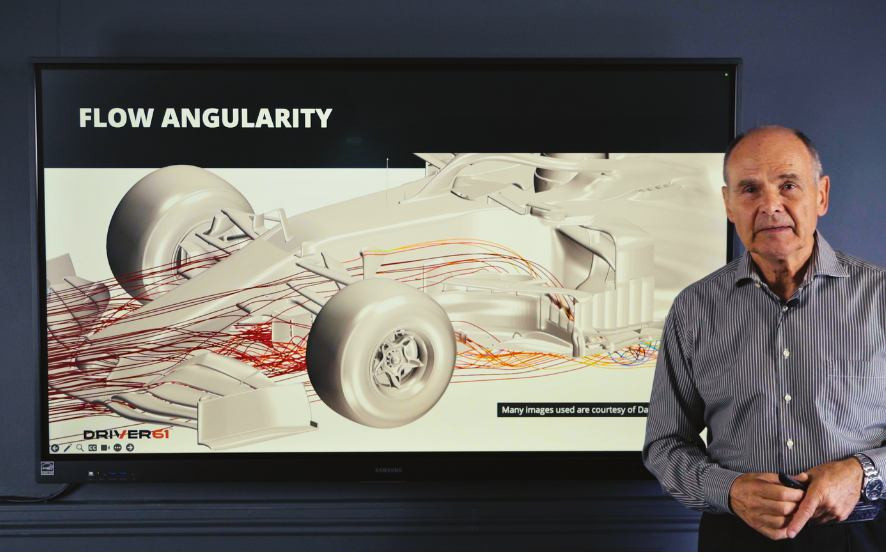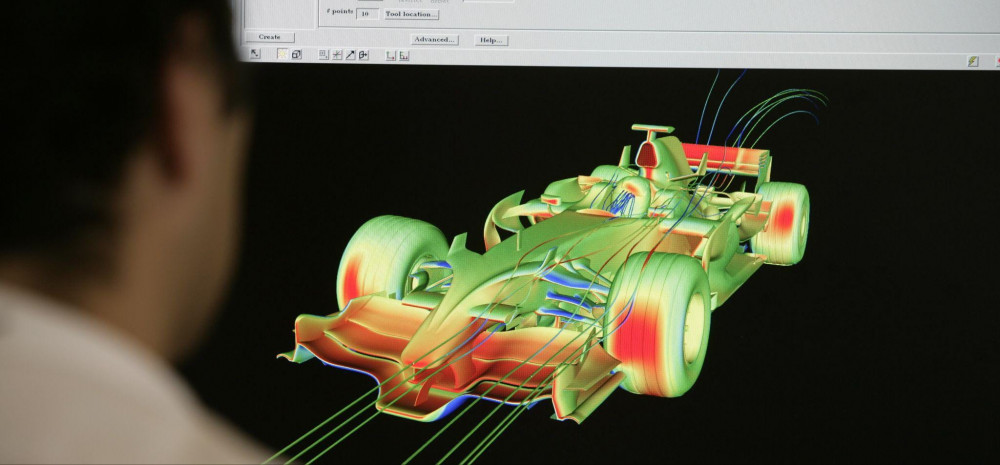Among the most vital components in a current regulation Formula 1 car's aerodynamic package are the floor, and diffuser. These elements, usually hidden from view (unless we get a cheeky look), are responsible for generating the vast majority of the car's downforce while producing as little drag as possible.
The regulations change in 2022 brought a renewed focus to floor and diffuser design, not seen for almost 40 years.
The changes were introduced to reduce the turbulent wake behind cars which made F1 cars very difficult to follow (and therefore, race!). As a result of the regs changes, teams had to completely reimagine their approach to underfloor aerodynamics, which, as we know, led to some turbulent times for a few teams in the paddock. Until 2022, much of the knowledge required had been lost to history (unless of course, you're Adrian Newey).
Historical Context and Regulatory Evolution
The story of Formula 1 floor and diffuser design is one of constant evolution, driven by both technological advancements and regulatory changes.

Lotus 79 at the 1978 Belgium GP
In the late 1970s, teams began to exploit the “ground effect”, using shaped underbodies to create a low-pressure area beneath the car, effectively sucking it to the ground. Refinements in the designs led, inevitably, to faster and faster cars. This raised serious safety concerns.
In response, the FIA (Fédération Internationale de l'Automobile) implemented a series of rule changes.
Here’s a simplified timeline:
- 1983: Flat bottoms were mandated, significantly reducing ground effect.
- 1994: A wooden plank was introduced to ensure cars maintained a minimum ride height.
- 2022: Ground effect was reintroduced in a controlled manner, with teams allowed to use shaped underbodies and Venturi tunnels.
As all race engineers know, regulations are there to be analysed, tested, loopholes found – all in the name of finding the next big advantage.
Basic Principles of F1 Floor and Diffuser Aerodynamics
The fundamental principle behind F1 floor and diffuser aerodynamics is the manipulation of airflow to create areas of low pressure beneath the car.

This is achieved through a combination of ground effect and the Bernoulli principle.
Ground effect occurs when a shaped surface close to the ground accelerates airflow, creating a low-pressure area. This effect is enhanced by sealing the sides of the floor, preventing high-pressure air from equalising the low-pressure area.
The Bernoulli principle states that as the velocity of a fluid increases, its pressure decreases. In the context of an F1 car, air is accelerated as it passes through the narrow gap between the floor and the ground, creating a low-pressure area that pulls the car downwards.
Unlike conventional ducted diffusers, which rely on arguably simpler two-dimensional flow expansion, F1 diffusers operate in a three-dimensional environment. This allows them to work effectively at much higher expansion angles than would be possible in a closed duct.
Detailed Floor and Diffuser Geometry
The floor of an F1 car consists of several key components, many of you will have seen these on TV when a car is being lifted for recovery.

1. Flat bottom: A regulated flat surface extending from the front of the sidepods to the start of the diffuser.
2. Plank: A wooden strip running along the car's centreline to enforce minimum ride height.
3. Transition to diffuser: The area where the flat bottom begins to curve upwards.
The diffuser itself is a shaped channel at the rear of the car that allows the air flowing under the car to expand and slow down. The expansion ratio of the diffuser (the ratio between its inlet and outlet areas) is a key parameter in its design.
The 2022 regulations reintroduced Venturi tunnels, which are shaped passages under the sidepods that accelerate the airflow. These tunnels create a more powerful ground effect, allowing teams to generate significantly more downforce with less reliance on wings and other external aerodynamic devices.
The Diffuser Gutter Concept
One of the most intriguing developments in recent F1 floor design is the "diffuser gutter". This concept, which exploits a loophole in the regulations, allows teams to effectively start the diffuser expansion earlier than intended by the rules.

Aerodynamic gutter (red arrow)
The gutter is created by using the maximum allowed radius (100mm) to curl the floor edge upwards at the point where the diffuser regulations begin. This creates a step in the floor, followed by a downward step into the main diffuser volume. The result is a channel or "gutter" along the outer edge of the diffuser.
This aerodynamic gutter serves two primary purposes:
1. It allows the diffuser to start expanding further forward, increasing its effective volume.
2. It can help manage and direct airflow, potentially improving the overall performance of the diffuser or reducing drag elsewhere in the car’s design.
The use of gutters varies between teams, with some employing more aggressive designs than others. The effectiveness of a gutter design can depend on various factors, including the overall aerodynamic philosophy of the car and its typical operating ride height.
Advanced Aerodynamic Mechanisms
The floor and diffuser work in concert with other aerodynamic elements to create a complex, three-dimensional flow structure. Key to this are the vortices generated along the edges of the floor and within the diffuser.

Image credit: TotalSim
These vortices serve several purposes:
1. They act as air "curtains", helping to seal the low-pressure area under the car.
2. They energise the airflow, helping to prevent separation in areas of adverse pressure gradient.
3. They can be used to direct airflow to specific areas, such as cooling inlets or the rear wing.
The interaction between the floor, diffuser, and other components like the rear wing and wheels is crucial. For example, the upwash created by the diffuser can be used to enhance the performance of the rear wing.
Regulatory Constraints and Design Optimisation
F1 engineers must work within a complex set of rules that govern floor and diffuser design. These rules define specific "boxes" within which certain geometries are allowed, as well as continuity and radius restrictions.
Key regulatory constraints include:
- A maximum radius of 100mm for floor edge curls.
- Specific height limits for different parts of the floor and diffuser.
- Rules governing the continuity of surfaces and the creation of enclosed holes.
Teams exploit ambiguities and loopholes in these rules to gain performance advantages. The diffuser gutter concept is a prime example of this, allowing teams to effectively increase diffuser volume within the letter, if not the spirit, of the regulations.
Performance Impact and Design Considerations
The floor and diffuser can contribute up to 60% of a car's total downforce while generating relatively little drag (compared to the front and rear wing). This makes them incredibly efficient aerodynamic devices.
However, their performance is highly sensitive to ride height. At very low ride heights, the downforce can increase dramatically, but there's also a risk of the airflow "stalling" if the gap to the ground becomes too small. This can lead to a sudden loss of downforce and potential instability.
What Porpoising Feels Like | Formula 1 Testing 2022
The "porpoising" effect seen in early 2022 cars was a result of this sensitivity. As the car gained speed, downforce would increase, lowering the ride height until the airflow stalled. The resulting loss of downforce would cause the car to rise, reattaching the airflow and starting the cycle again. The downforce effect would become spiky and unpredictable. Not ideal for a car that relies on aerodynamics for its pace.
Managing flow separation and ensuring stable performance across a range of conditions are key challenges in floor and diffuser design.
Technological Innovations in Floor Design
Advancements in materials and manufacturing techniques have allowed for increasingly complex and precise floor designs. Carbon fibre composites are extensively used for their high strength-to-weight ratio and ability to be formed into complex shapes.

Computational Fluid Dynamics (CFD) and wind tunnel testing play crucial roles in the development of floor and diffuser designs. These tools allow engineers to simulate and optimise designs before committing to expensive prototypes.
Some teams have explored active floor technologies, such as flexible elements that change shape with speed or load. While many of these concepts are currently prohibited by regulations, they represent potential future directions for floor design.
Team-Specific Approaches and Variations
Different teams have adopted varying approaches to floor and diffuser design based on their overall car philosophy and strengths.
For example, some teams have favoured high-rake designs (where the car runs with its rear higher than the front), while others have opted for low-rake approaches. Each of these philosophies requires a different approach to suspension, floor and diffuser design.
The implementation of features like diffuser gutters also varies between teams. Some have adopted aggressive gutter designs, while others have chosen to forgo them entirely, possibly due to concerns about crosswind sensitivity or performance at higher ride heights.
Teams must also adapt their designs to suit different tracks and conditions. A design that works well on smooth, high-speed circuits may be less effective on bumpier, slower tracks.
The floor and diffuser remain critical components in Formula 1 aerodynamics, representing a fascinating intersection of engineering ingenuity and regulatory compliance.
As teams continue to push the boundaries of what's possible within the rules, we can expect to see ongoing innovation in this area.
Future trends may include:
- Further refinement of Venturi tunnel designs
- Increased integration of floor aerodynamics with other car systems
- Exploration of active or adaptive floor technologies, when the 2026 regulations come into force.
Sources:
1. [Willem Toet explains motorsport diffusers](https://www.racetechmag.com/2017/08/willem-toet-explains-motorsport-diffusers/)
2. [How Floor Work Boosts Performance in Formula 1](https://motorsportengineer.net/how-floor-work-boosts-performance-in-formula-1/)
3. [KYLE.ENGINEERS YouTube video on F1 diffuser gutters](https://www.youtube.com/watch?v=0G_uC8Nf1G0)




